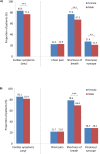IMPULSE: the impact of gender on the presentation and management of aortic stenosis across Europe
- PMID: 33419934
- PMCID: PMC7798778
- DOI: 10.1136/openhrt-2020-001443
IMPULSE: the impact of gender on the presentation and management of aortic stenosis across Europe
Abstract
Aims: There is an increasing awareness of gender-related differences in patients with severe aortic stenosis and their outcomes after surgical aortic valve replacement (SAVR) and transcatheter aortic valve implantation (TAVI).
Methods: Data from the IMPULSE registry were analysed. Patients with severe aortic stenosis (AS) were enrolled between March 2015 and April 2017 and stratified by gender. A subgroup analysis was performed to assess the impact of age.
Results: Overall, 2171 patients were enrolled, and 48.0% were female. Women were characterised by a higher rate of renal impairment (31.7 vs 23.3%; p<0.001), were at higher surgical risk (EuroSCORE II: 4.5 vs 3.6%; p=0.001) and more often in a critical preoperative state (7.0vs 4.2%; p=0.003). Men had an increased rate of previous cardiac surgery (9.4 vs 4.7%; p<0.001) and a reduced left ventricular ejection fraction (4.9 vs 1.3%; p<0.001). Concomitant mitral and tricuspid valve disease was substantially more common among women. Symptoms were highly prevalent in both women and men (83.6 vs 77.3%; p<0.001). AVR was planned in 1379 cases. Women were more frequently scheduled to undergo TAVI (49.3 vs 41.0%; p<0.001) and less frequently for SAVR (20.3 vs 27.5%; p<0.001).
Conclusions: The present data show that female patients with severe AS have a distinct patient profile and are managed in a different way to males. Gender-based differences in the management of patients with severe AS need to be taken into account more systematically to improve outcomes, especially for women.
Keywords: aortic valve stenosis; endovascular procedures; transcatheter aortic valve replacement.
© Author(s) (or their employer(s)) 2021. Re-use permitted under CC BY-NC. No commercial re-use. See rights and permissions. Published by BMJ.
Conflict of interest statement
Competing interests: PB is the representative of the IPPMed, Cloppenburg, Germany. NF, RPS and DM-Z have received honoraria for advisory board meetings and TKR speakers’ honoraria from Edwards Lifesciences. The institutions of these three and those of the remaining authors representing study centres have received funding for employing a study nurse. JK and MT are employees of the funder of this registry. As this is a disease registry, neither the type of intervention (SAVR, TAVI or medical management) nor on the valves to be used was pre-specified.
Figures



Similar articles
-
Propensity score matched comparison of transcatheter aortic valve implantation versus conventional surgery in intermediate and low risk aortic stenosis patients: A hint of real-world.Cardiol J. 2016;23(5):541-551. doi: 10.5603/CJ.a2016.0051. Epub 2016 Jul 21. Cardiol J. 2016. PMID: 27439368
-
A comparison of transcatheter aortic valve implantation and surgical aortic valve replacement in 1,141 patients with severe symptomatic aortic stenosis and less than high risk.Catheter Cardiovasc Interv. 2015 Oct;86(4):738-44. doi: 10.1002/ccd.25866. Epub 2015 Mar 17. Catheter Cardiovasc Interv. 2015. PMID: 25641398
-
The impact of the development of transcatheter aortic valve implantation on the management of severe aortic stenosis in high-risk patients: treatment strategies and outcome.Eur J Cardiothorac Surg. 2017 Jan;51(1):80-88. doi: 10.1093/ejcts/ezw211. Epub 2016 Aug 30. Eur J Cardiothorac Surg. 2017. PMID: 27582074
-
Transcatheter Versus Surgical Aortic Valve Replacement: An Updated Systematic Review and Meta-Analysis With a Focus on Outcomes by Sex.Heart Lung Circ. 2021 Jan;30(1):86-99. doi: 10.1016/j.hlc.2020.05.112. Epub 2020 Jul 12. Heart Lung Circ. 2021. PMID: 32732125
-
Updated clinical indications for transcatheter aortic valve implantation in patients with severe aortic stenosis: expert opinion of the Italian Society of Cardiology and GISE.J Cardiovasc Med (Hagerstown). 2018 May;19(5):197-210. doi: 10.2459/JCM.0000000000000636. J Cardiovasc Med (Hagerstown). 2018. PMID: 29578921 Review.
Cited by
-
Sex-related differences among patients undergoing surgical aortic valve replacement-a propensity score matched study.Interdiscip Cardiovasc Thorac Surg. 2024 Aug 1;39(2):ivae140. doi: 10.1093/icvts/ivae140. Interdiscip Cardiovasc Thorac Surg. 2024. PMID: 39128016 Free PMC article.
-
The Evolution of Pulmonary Hypertension and Its Prognostic Implications Post-TAVI-Single Center Experience.Medicina (Kaunas). 2022 Aug 30;58(9):1182. doi: 10.3390/medicina58091182. Medicina (Kaunas). 2022. PMID: 36143859 Free PMC article.
-
Understanding Aortic Stenosis and Transcatheter Aortic Valve Replacement in Women.Struct Heart. 2025 May 30;9(7):100666. doi: 10.1016/j.shj.2025.100666. eCollection 2025 Jul. Struct Heart. 2025. PMID: 40704359 Free PMC article. Review.
-
Sex differences in aortic stenosis: Identification of knowledge gaps for sex-specific personalized medicine.Am Heart J Plus. 2022 Sep;21:100197. doi: 10.1016/j.ahjo.2022.100197. Epub 2022 Aug 25. Am Heart J Plus. 2022. PMID: 36330169 Free PMC article.
-
Under-representation of Women as Proceduralists and Patients in TAVR and TMVr Procedures: Data, Implications and Proposed Solutions.Eur Cardiol. 2022 Dec 19;17:e27. doi: 10.15420/ecr.2022.33. eCollection 2022 Feb. Eur Cardiol. 2022. PMID: 36845217 Free PMC article. Review.
References
Publication types
MeSH terms
LinkOut - more resources
Full Text Sources
Other Literature Sources
Research Materials
Miscellaneous
